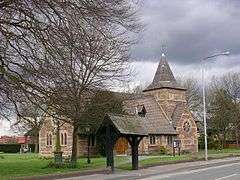Irlam
| Irlam | |
 St. John's Church |
|
 Irlam |
|
| Population | 19,933 (2011) |
|---|---|
| OS grid reference | SJ725945 |
| – London | 166 mi (267 km) SE |
| Metropolitan borough | Salford |
| Metropolitan county | Greater Manchester |
| Region | North West |
| Country | England |
| Sovereign state | United Kingdom |
| Post town | MANCHESTER |
| Postcode district | M44 6 |
| Dialling code | 0161 |
| Police | Greater Manchester |
| Fire | Greater Manchester |
| Ambulance | North West |
| EU Parliament | North West England |
| UK Parliament | Worsley and Eccles South |
|
|
Coordinates: 53°26′42″N 2°25′19″W / 53.445°N 2.422°W
Irlam is a suburb of Salford in Greater Manchester, England. Historically in Lancashire, in 2001 it had a population of 18,504, increasing to 19,933 at the 2011 Census.[1] It lies on flat ground on the south side of the M62 motorway and the north bank of the Manchester Ship Canal, and is 6.7 miles (10.8 km) west-southwest of Salford, 7.6 miles (12.2 km) west-southwest of Manchester and 8.3 miles (13.4 km) east-northeast of Warrington. Irlam forms a continuous urban area with Cadishead to the southwest, and is divided from Flixton and the Metropolitan Borough of Trafford to the southeast by the Manchester Ship Canal. The main road through Irlam linking it to Cadishead and Eccles is the A57. For train services, Irlam railway station serves the district.
Irlam was anciently known as Irwellham, and was an outlying area of Chat Moss, a large peat bog which straddled the River Irwell. Work was carried out during the 19th century to reclaim large areas of Chat Moss to enable the completion of the Liverpool and Manchester Railway in 1829. In 1894 the Irwell was adjusted so that its waters were united with the Manchester Ship Canal, stimulating the growth of Irlam as an inland port. Irlam Urban District was established in the same year and was governed thereafter by its own district council until its abolition in 1974.
Irlam's geography is varied; the northern half continues to exist as moss land, enabling the area to have the largest farming community in Greater Manchester. The southern half is predominantly residential, and has a major employment source at the Northbank Industrial Estate.
History
Irlam is situated on the north bank of the River Irwell, from which it almost certainly takes its name, being known in the 13th century as Irwellham.[2] Until around the time of the arrival of the Cheshire Lines Committee railway and the opening of Irlam railway station, in 1873, Irlam remained a largely undeveloped village, on the southern edge of the peat bog known as Chat Moss.[3]
From at least the beginning of the 13th century, Irlam was held by the Irlam family, whose seat was Irlam Hall. By 1688 Irlam Hall had become the home of Thomas Latham, who played an important part in bringing William of Orange to the throne of England in 1689.[4]
Irlam Urban District was created in 1894, the same year that the Manchester Ship Canal opened. A pair of locks and a ship coaling berth were constructed here. The subsequent industrial development of Irlam owed much to the construction of the canal, which effectively rendered the River Irwell navigable to large ocean-going ships up to Manchester Docks. The Latham family's importance to the local area was acknowledged when their features were incorporated into the arms of Irlam's former urban district council.[3]
Council-owned housing passed to the City West Housing Trust. It was while renovating some of these properties at 7:00 am on 2 November 2010, that there was a large gas explosion. Four houses were destroyed, 15 people were injured and 80 families were subsequently evacuated. There were no fatalities.[5]
Economy
Steel manufacture was a major source of employment in Irlam for a large part of the 20th century. The Partington Steel and Iron Company opened the first steelworks in Irlam, in 1910. It subsequently became a part of the Lancashire Steel Corporation, and later British Steel Corporation. Rationalisation and the concentration of steel manufacture into fewer, larger sites, meant that by 1979, all steel production in Irlam had ceased.[6] The former steelworks are now the site of Northbank Industrial Estate.
Kingsland Wine & Spirits, the UK's largest independent wine bottler, operates from a 35-acre (14 ha) site in Irlam, formerly a soapworks established in 1895. The company employs 300 people.[7]
Sport
Irlam F.C. is an amateur association football club that plays in the Premier Division of the Manchester Football League and has its ground in Silver Street. There are two junior football teams in the area, one of them being Irlam Vale F.C..
Irlam Hornets Rugby League Club is a reformed rugby league club. Irlam Cricket Club plays in the Greater Manchester Cricket League, and Fit City is a leisure centre, with a swimming pool and fitness gym.
References
Notes
- ↑ "Town population 2011". Retrieved 7 January 2016.
- ↑ "Townships:Barton". A History of the County of Lancaster: Volume 4. 1911. Retrieved 26 June 2007.
- 1 2 "Irlam & Cadishead – Local History". Salford City Council. Retrieved 24 April 2007.
- ↑ Cooper, Salford: An Illustrated History, p. 169.
- ↑ Carter, Helen (2 November 2010), "Salford gas explosion leaves 15 injured", The Guardian
- ↑ Eyewitness in Manchester, Manchester Online, archived from the original on 2007-09-29, retrieved 28 June 2007
- ↑ "From the New World to Irlam with Kingsland Wines" ((subscription or UK public library membership required)), Manchester Evening News, 11 March 2010, retrieved 28 February 2011 Check date values in:
|access-date=(help)
Bibliography
- Cooper, Glynis (2005). Salford: An Illustrated History. The Breedon Books Publishing Company. ISBN 1-85983-455-8.
External links
| Wikimedia Commons has media related to Irlam. |